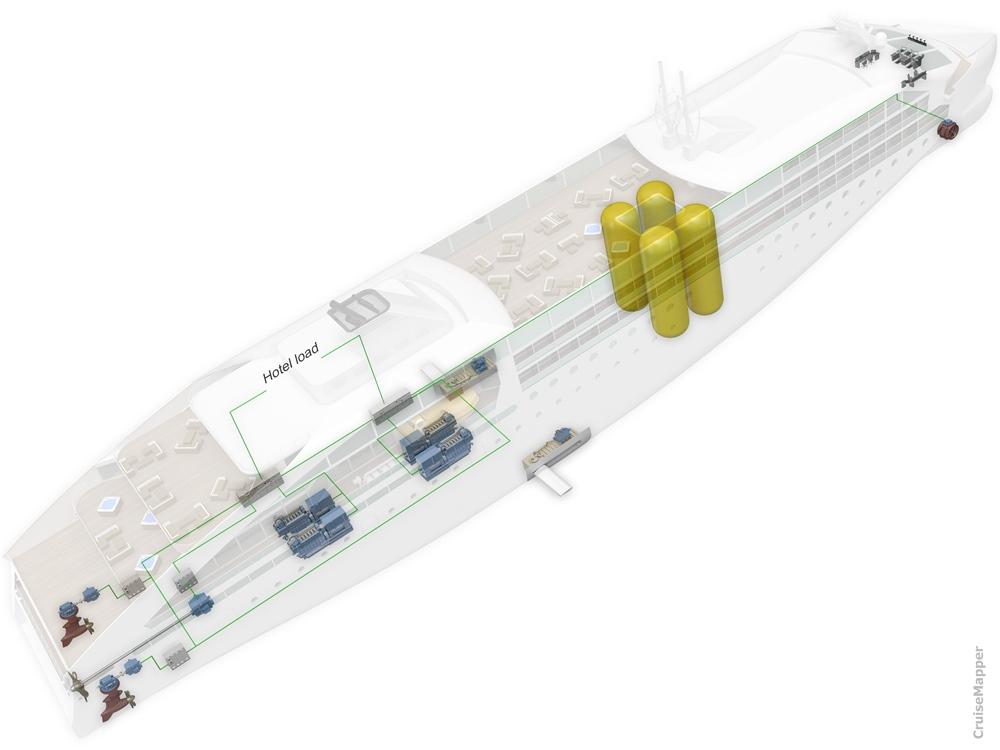Table Of Content

The decibel range for the engine of a standard cruise ship exceeds 173 decibels. This is extremely loud and within a range that can damage hearing in seconds. Thanks to proper insulation and sound-reducing features, it won’t sound that loud. Discover these hand-picked articles to learn about the many solutions for future-proof, sustainable cruise ship operations. In the aftermath of the Carnival Triumph fire, Carnival Cruise Line announced steps that exceeded the "Safe Return to Port" regulations. Every one of its ships was involved in a fleetwide $300 million retrofit and received an additional emergency generator to power 100 percent of stateroom and public toilets, fresh water and elevators.
It's All About the Power

LNG (liquefied natural gas) is emerging as a promising alternative fuel for cruise ship engines, offering significant environmental and operational advantages. LNG-powered engines utilize natural gas in its liquefied state as the primary fuel source, resulting in reduced emissions and improved fuel efficiency. Cruise ships are marvels of modern engineering, offering unforgettable experiences on the high seas. As these magnificent vessels sail across oceans, powering their immense size and providing luxurious amenities to passengers requires robust and efficient engines.
Hydrogen Fuel
This creates pressure/speed difference that moves it in the direction of the opposite (lower-pressure) side, creating a force at a right angle to the direction of the wind. Unlike traditional cloth sails, the rotor needs no furling (stowing), reefing (reducing sail's area) or line-tending. The rotor sail system is automated and shuts down when unfavorable changes in wind force or direction occur.
Biggest Ship Propellers in the World
The next scheme shows the dual-engine powerplant (Wartsila) and propulsion (Azipod) of the cruise ferryTallink Megastar. This ship is the biggest "floating superstore" on the Baltic Sea, featuring a 2-deck retail shopping complex and the unique self-service option called "Q-shopping". The RoPax vessel uses LNG as prime fuel and MDO (marine diesel oil) as secondary fuel. AIDAprima (2016) is one of the world's most technologically advanced cruise vessels. The ship rides on a cushion of air, thus reducing frictions and fuel consumption, The new technology is called MALS ("Mitsubishi Air Lubrication System"), allowing the liner to glide on an air bubbles carpet.
Latest Wärtsilä engine to make its debut powering new luxury cruise ships - Wärtsilä
Latest Wärtsilä engine to make its debut powering new luxury cruise ships.
Posted: Thu, 05 Oct 2023 07:00:00 GMT [source]
This blog helps over a million people to plan their cruises each month. She has worked in the cruise industry since 2015 and has taken over 30 cruises. Now, she helps over 1 million people per month to plan their perfect cruise holidays.

Flexibility of engine-room layout and huge space saving
Buoyancy is made alternatively negative and positive, generating tooth-saw profiles. If you have ever taken a cruise or seen one come into port, you may have wondered what it makes it move. At the following tag-link can be found listed all CruiseMapper's news related to propulsion-power accidents. For its LNG-bunkering operations in Florida (at homeports PortMiami and Port Canaveral), CCL-Carnival partnered with Royal Dutch Shell plc as fuel supplier for the liners Mardi Gras (2021) and Celebration (2022). Currently, NCL Norwegian Epic has two rudders with conventional non-Azipod screws.
Importance of Engines for Cruise Ships
So a cheap room that knocks 70% off the price of your holiday is well worth the sacrifice, in my opinion. There are loads of things to do and staying in your cabin will probably be the absolute last thing on your mind for anything other than brief periods of sleep. Space is needed not only for the massive engines, but for fuel tanks, generators, the engine workshop, and the control room.
If your cabin is towards the bow, you may be awoken by the sound of the anchor being raised and lowered. Or, if your room is by the elevator, you may hear lots of other guests chatting as they stagger to bed in the early hours of the morning. There’s also a hidden advantage that those new to cruising probably never consider. You can purchase a cabin that’s near the engine room for an outstanding price, with the option to upgrade.
Conventional Diesel
This allows emerging problems and engine fault sources to be fixed before they occur. While it won't be for awhile, we are looking forward to when the fifth Edge Class ship's flex fuel engine is started up for the first time. The time between overhauling of different parts of the engine is provided by the manufacturer in the engine manual. The maintenance needs to be performed as per the time specified between two overhauling durations, irrespective of issues shown by the engine. The ship’s engine can also be made in reputed shipyard if there is a contract between the two companies.
Cruise ships use power equivalent to approximately 50,000 horsepower, with one horsepower equal to 746 watts. A ship engine is designed to directly drive huge propellers, or produce electricity that is diverted to drive the propellers. A cruise ship can travel at remarkably fast speeds of around 30 miles per hour without undue stress on the engine; a remarkable feat or marine engineering. Overall, minimizing the environmental impact of cruise ships through engine selection is a top priority for the industry. Modern cruise ship engines are designed to meet increasingly stringent emissions regulations, such as the International Maritime Organization’s (IMO) MARPOL Annex VI standards.
"As we innovate our ship design and offerings, we're also focused on equally evolving the fuel and technology landscape that powers them," said Jason Liberty, president and CEO, Royal Caribbean Group. Apart from timely overhauling, the engine ratings and power needs to be checked using digital power indicator. The scavenge space inspection is also done to check the condition of the piston ring, which in turn defines the efficiency of the lubrication system of the cylinder liner.
These marine engines are built at the facilities of the manufacturers. MAN Diesel has production facilities in Augsburg, Copenhagen, Frederikshavn, Saint-Nazaire, Shanghai, etc. The 2 stroke engines are used for vessel propulsion and are bigger in size as compared to the 4 stroke engines. In this engine, the complete sequence is complete in two cycles i.e.
The biggest ships like Royal Caribbean’s Oasis-class ships have six engines and most other cruise ships have four. The standard cruise ship engine can have a decibel range that exceeds 173 decibels. This is frighteningly loud and well into the range in which hearing damage occurs quickly. However, thanks to insulation and other sound reduction technology, it’s not nearly that loud in practice. Most often, especially in newer cruise ships, the engines are located on the lower decks and towards the aft of the ship.
LNG-powered engines, in particular, have gained popularity due to their lower emissions and improved fuel efficiency. The main engines and even the generators themselves require electricity to keep going. Electrically driven pumps take in cold seawater from the ocean to help cool the engines; electrical pumps take fuel from the fuel tanks and supply it to the engine. Electrical power is critical to many operating functions, and without it, the ship comes to a halt. The latest generation of cruise ships are equipped with diesel electric engines.

No comments:
Post a Comment